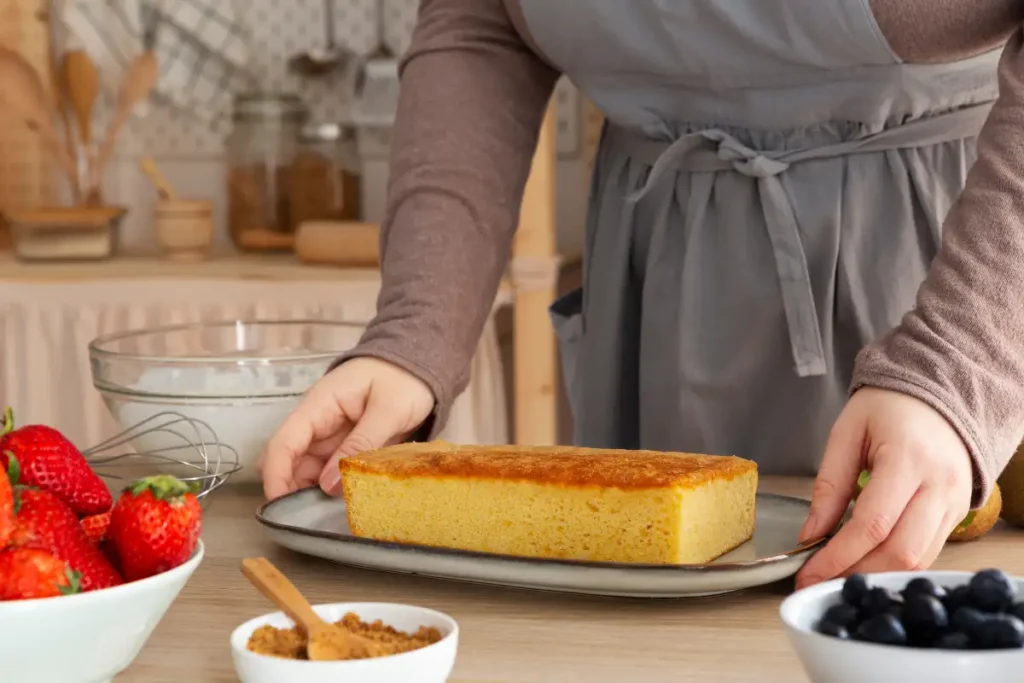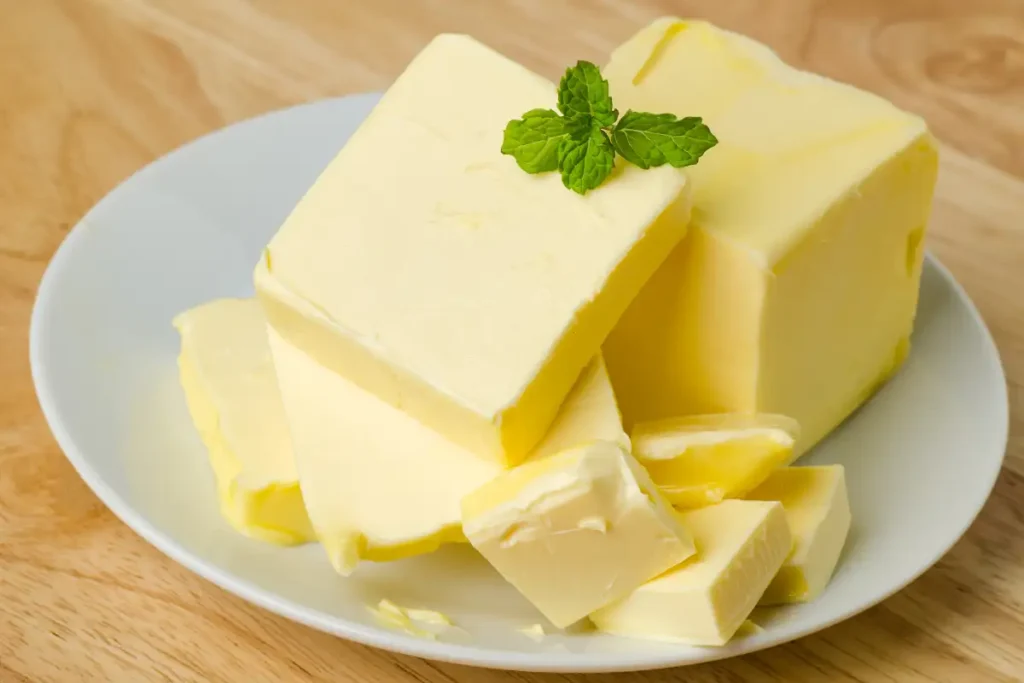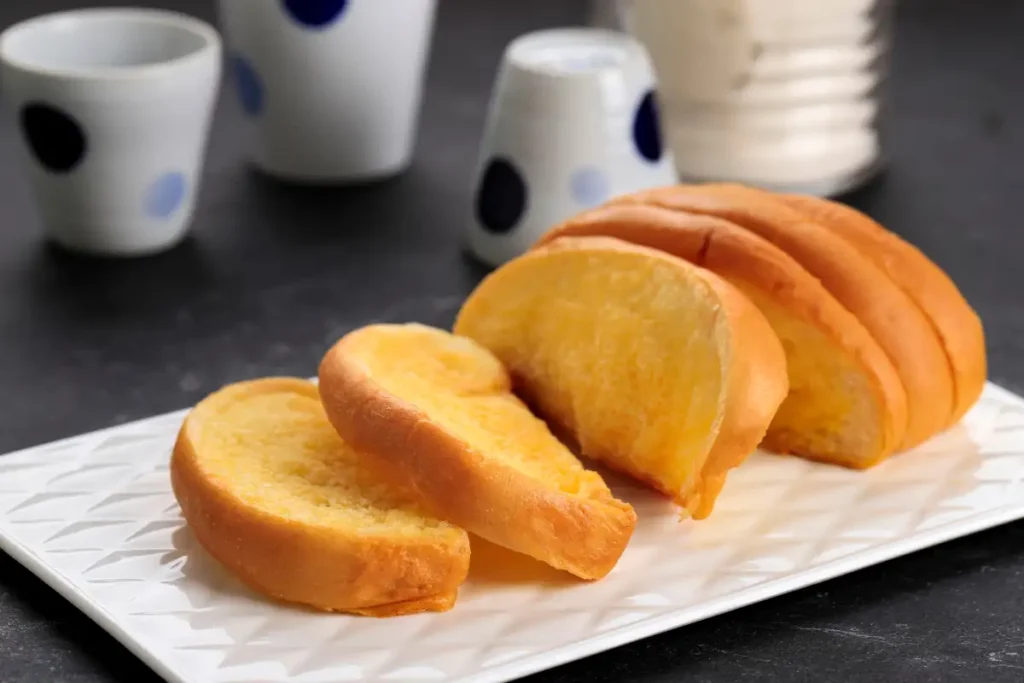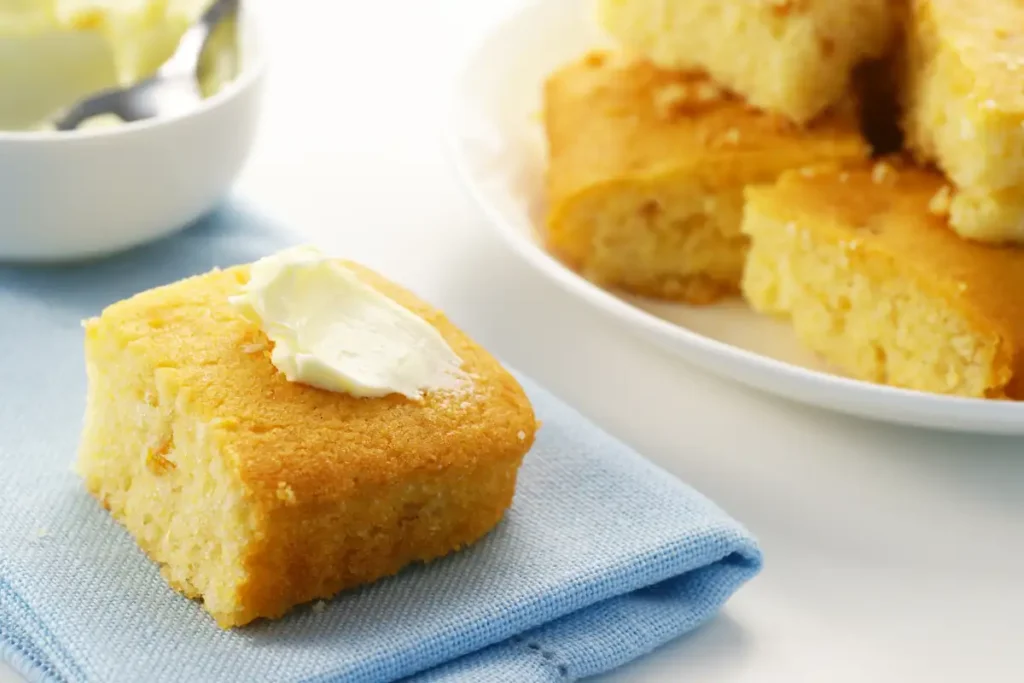
Introduction
When it comes to baking, the debate between using butter and margarine is as old as time. These two fats seem interchangeable at a glance, but when we delve deeper, significant differences emerge, particularly in the context of cake baking. This article aims to provide a comprehensive comparison of butter cakes and margarine cakes, directly addressing the “Difference Between Butter Cake and Margarine Cake.” We’ll explore how each ingredient influences the taste, texture, and overall quality of your baked goods. To get a taste of how butter can enhance your baking, check out this delicious Salted Caramel Kentucky Butter Cake recipe, ensuring you have all the information needed to make an informed choice for your next baking project.
Understanding Butter and Margarine
Before we jump into the nitty-gritty of baking, let’s break down what butter and margarine are and how their differences might affect your next baking adventure.
Composition and Nutritional Profile
Butter is a dairy product made from churning cream or milk, separating the solid fats from the liquid. Rich in saturated fats, it has been a staple in cooking and baking for centuries. On the other hand, margarine is a non-dairy product created from vegetable oils and contains more unsaturated fats. The nutritional profiles of these fats are quite distinct:
- Butter:
- High in saturated fats
- Contains cholesterol
- Source of fat-soluble vitamins (A, D, E, and K)
- Margarine:
- Higher in unsaturated fats
- Often fortified with vitamins
- May contain trans fats, depending on the manufacturing process
Flavor and Texture in Baking
The flavor and texture that butter and margarine impart to cakes are markedly different. Butter’s rich, creamy taste is hard to mimic, giving butter cakes a luxurious and indulgent flavor. Its high-fat content also contributes to a tender crumb and moist texture in cakes.
Margarine, while versatile, often lacks the depth of flavor that butter offers. It can also affect the texture of cakes; some bakers find that margarine-based cakes are less moist and have a different crumb structure compared to their buttery counterparts.

Butter in Baking
Benefits of Using Butter
Butter is not just an ingredient; it’s a cornerstone of flavor and texture in baking. Here’s why many bakers swear by butter for their cakes:
- Rich Flavor: Butter’s unmistakable taste is a result of its milk fat content, providing a richness that margarine struggles to match. This rich flavor is especially crucial in butter cakes, where butter is a star player, not just a background ingredient.
- Texture: The melting point of butter aligns beautifully with baking temperatures, allowing it to create steam during the baking process. This steam contributes to a rise in the cake, giving it a light and fluffy texture. Additionally, butter’s fat content ensures a moist crumb, which is often sought after in cakes.
- Versatility: Whether you’re creaming it with sugar or melting it down, butter’s consistency and behavior in recipes are predictable and reliable. This reliability is key in baking, where precision is everything.
- Color and Aroma: During the baking process, butter undergoes Maillard reactions, contributing to a golden-brown crust and a delightful aroma. These sensory attributes can elevate a simple cake to something extraordinary.
Potential Drawbacks
Despite its advantages, butter isn’t without its drawbacks in baking:
- Saturated Fats: Butter’s high saturated fat content is a health concern for some individuals. While it contributes to flavor and texture, it’s worth considering the dietary implications, especially if consumed frequently.
- Cost: High-quality butter can be more expensive than margarine, which might be a deciding factor for some bakers or commercial bakeries.
- Storage and Preparation: Butter requires softening before use, which can add an extra step to your baking process. It also needs refrigeration, unlike some margarines that are shelf-stable.
In the next section, we’ll explore margarine’s role in baking, examining when it might be a suitable choice and the challenges it presents.

Margarine in Baking
Now, let’s switch gears and discuss the use of margarine in baking. While it may not be the first choice for purists, margarine has its place in the kitchen, offering benefits under certain circumstances.
When to Choose Margarine
Margarine can be a suitable alternative to butter in baking due to several reasons:
- Dietary Restrictions: For those who avoid dairy due to allergies, ethical reasons, or health concerns, margarine offers a viable plant-based alternative.
- Cost-Effectiveness: Generally, margarine is cheaper than butter. This cost difference can be significant, especially in large-scale baking operations or for budget-conscious home bakers.
- Health Considerations: Some margarines are formulated to be lower in saturated fats and free from cholesterol, appealing to health-conscious individuals.
- Consistency: Margarine’s consistency can be more uniform than butter, providing consistent results in baking, particularly in terms of spreadability and texture.
Challenges with Margarine
Despite its advantages, baking with margarine comes with its own set of challenges:
- Water Content: Margarine often contains more water and less fat than butter, which can affect the texture and rise of cakes. This higher water content can lead to cakes that are less tender and more prone to becoming soggy.
- Flavor: Many bakers find that margarine lacks the rich flavor that butter provides. This can result in baked goods that are less flavorful and have a more artificial taste.
- Trans Fats: Some margarines contain trans fats, which have been linked to various health issues. It’s essential to choose a margarine that is labeled as “trans-fat-free.”
- Variability: With so many types of margarine available, results can vary widely depending on the brand and formulation. This variability can make it tricky to achieve consistent results in baking.
Practical Baking Tips
Whether you choose butter or margarine for your baking endeavors, here are some practical tips to help you achieve the best results:
Achieving the Best Results with Butter or Margarine
- Room Temperature: Ensure your butter or margarine is at room temperature unless the recipe specifies otherwise. This makes it easier to cream with sugar, resulting in a lighter, airier cake texture.
- Measuring Accurately: Be precise with your measurements. The balance of fat is crucial in baking, affecting everything from texture to flavor.
- Creaming Process: When creaming butter or margarine with sugar, do it until the mixture is light and fluffy. This incorporates air into your batter, contributing to a better rise.
- Melting Matters: If a recipe calls for melted butter or margarine, allow it to cool slightly before adding it to your mixture to prevent cooking the eggs or affecting the batter’s temperature.
- Experiment: Don’t be afraid to experiment with recipes, substituting butter for margarine or vice versa. Note the differences in outcome to find what works best for your taste and texture preferences.

Expert Bakers’ Insights
- Flavor First: Many professional bakers prefer butter for its superior flavor, especially in recipes where its taste is prominent.
- Texture Considerations: Some bakers opt for margarine in recipes that require a crisper texture, as its higher water content can sometimes achieve this effect.
- Health Balance: Experts suggest considering the overall balance of your diet when choosing between butter and margarine, recommending moderation regardless of your choice.
FAQs:
Is it better to bake a cake with butter or margarine?
The choice between baking a cake with butter or margarine largely depends on your preferences and needs. Butter is renowned for its rich flavor and the ability to contribute to a tender, moist texture in cakes. On the other hand, margarine is a suitable option for those with dietary restrictions or budget constraints. If flavor and texture are your primary concerns, butter is typically the better choice. However, if you’re looking for a dairy-free alternative or aiming to reduce saturated fats, margarine might be preferable.
Do butter and margarine bake the same?
Butter and margarine do not bake the same due to differences in fat content and water content. Butter, with its higher fat content, tends to produce cakes with a richer flavor and more tender crumb. Margarine, often containing more water, can sometimes result in a different texture, potentially affecting the cake’s rise and moisture level. It’s also worth noting that the melting points of butter and margarine differ, which can influence the baking process and the final outcome of your baked goods.
Can you replace butter with margarine in a cake recipe?
Yes, you can replace butter with margarine in a cake recipe, but it’s important to be mindful of the potential changes in flavor and texture. Since margarine may have a higher water content, the outcome might not be identical to a cake made with butter. It’s generally recommended to use margarine that’s specifically labeled for baking, as it’s formulated to perform more similarly to butter in recipes.
What is the major difference between margarine and butter?
The major difference between margarine and butter lies in their origin and composition. Butter is a dairy product made from churned cream or milk, high in saturated fats and containing cholesterol. Margarine, on the other hand, is made from vegetable oils and is typically higher in unsaturated fats. It’s often fortified with vitamins and may contain trans fats, depending on the type. These fundamental differences influence their taste, texture, and how they behave in baking, impacting the flavor and structure of cakes and other baked goods.
Conclusion
Choosing between butter and margarine for baking is a decision that hinges on various factors, including dietary preferences, health considerations, budget constraints, and, most importantly, the desired outcome in terms of flavor and texture. Butter is celebrated for its unparalleled taste and contribution to the richness and moistness of cakes, making it a favorite among baking enthusiasts. Margarine, while offering a different flavor profile and texture, serves as a versatile, plant-based alternative that caters to specific dietary needs and budgetary considerations.
When deciding whether to use butter or margarine in your next baking project, consider what aspects are most important to you and how each ingredient aligns with your baking goals. Whether you choose the creamy richness of butter or opt for the convenience and dietary benefits of margarine, understanding their unique properties will help you make informed decisions, ensuring delightful results in your baking endeavors. For inspiration, check out this comprehensive guide to baking perfection with mini chocolate chip cookies, where the choice of fat can make all the difference.
Remember, the best baking ingredient is the one that suits your needs while delivering the taste and texture you desire. So, experiment, taste, and tweak your recipes to discover what works best for you, ensuring each cake you bake is a testament to your personal preferences and baking expertise.
